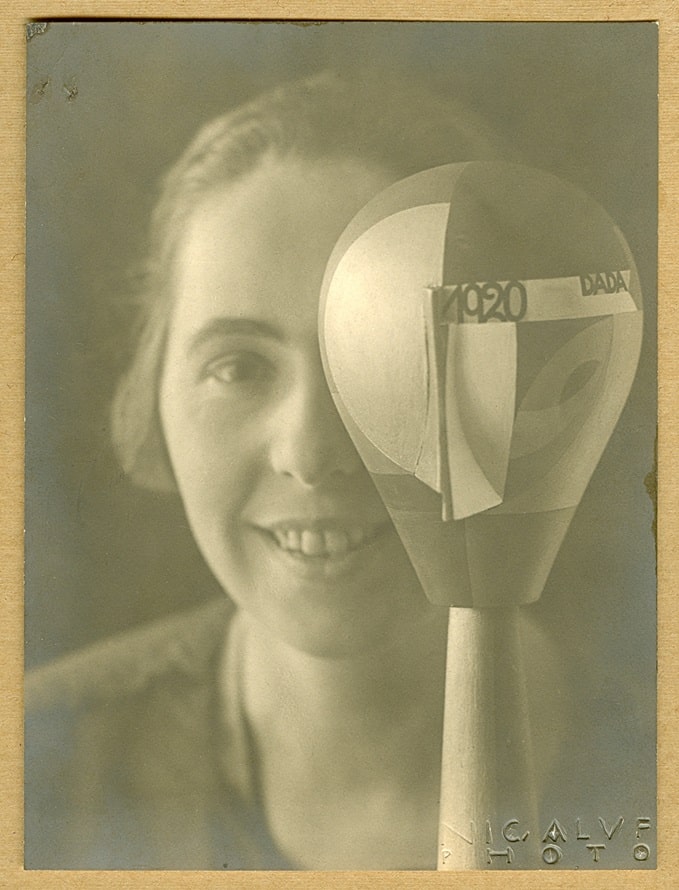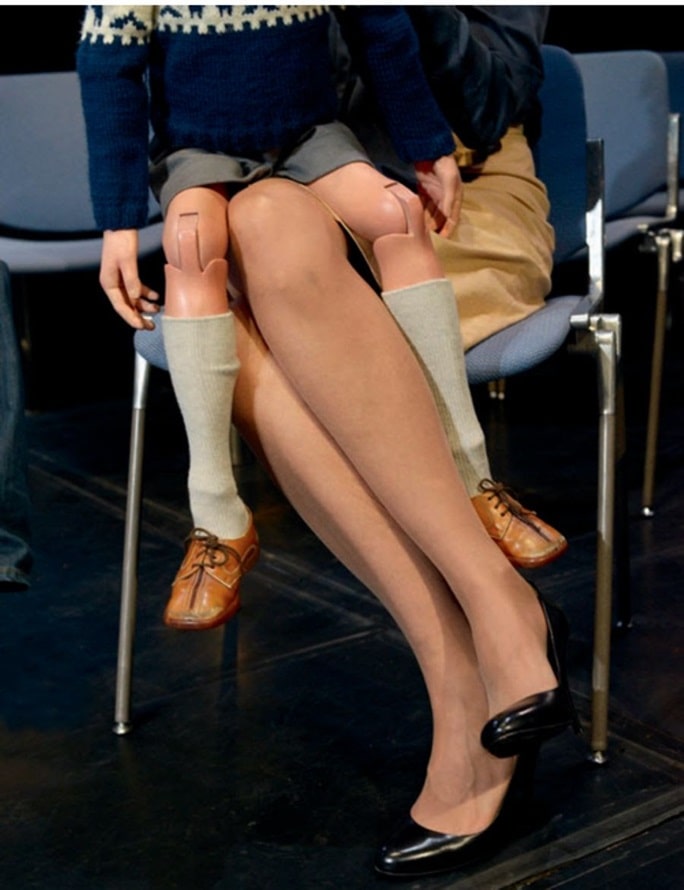The Georg Kolbe Museum is delighted to present the artistic work of the Austrian-French artist, choreographer and director GISÈLE VIENNE (*1976) for the first time in Berlin in fall 2024. The exhibition is taking place as part of Berlin Art Week and is part of a joint project with Haus am Waldsee, which is showing Gisèle Vienne’s work as a solo exhibition, and Sophiensælen, who are performing her play Crowd. In the exhibition at the Georg Kolbe Museum, Gisèle Vienne’s contemporary works enter into a cross-temporal dialog with historical works by artists of the European avant-garde – such as CLAUDE CAHUN, HANNAH HÖCH, SOPHIE TAEUBER-ARP and EMMY HENNINGS, as well as lesser-known artists such as HERMINE MOOS, MARIA JAREMA and MILADA MAREŠOVÁ. This encounter provides a unique insight into the multifaceted use of dolls in modern and contemporary art and addresses themes such as emancipation and social criticism.
Image above: Gisèle Vienne, FRANKY AND KERSTIN, Foto: Estelle Hanania © VG Bild-Kunst, Bonn 2024
Over more than two decades, Gisèle Vienne has created a complex and idiosyncratic body of work that questions our patterns of perception and uses new artistic languages to initiate structural social change. Vienne’s creations, both on stage and in her visual practice, are developed in collaboration with dancers and actors and are often animated by anthropomorphic figures and puppets. These life-size puppets, situated in figurative sculpture, unfold a political dimension in relation to the body as a contested site by questioning culturally and socially constructed patterns of perception. Through her spatial staging in the large studio of the Georg Kolbe Museum, Vienne explores the longings and fears of a youth in crisis, stages the feelings of her protagonists in their political and social aspects and thus explores the sensuality, anger and creativity of youth and countercultures in all their subversive potential.
Vienne’s film Kerstin Kraus, which was completed in 2024 especially for the exhibition at the Georg Kolbe Museum, will be shown for the first time. The film sheds light on the profound relationship between humans and dolls and explores the boundaries of identity and self-expression. Vienne’s visual storytelling deals with questions of existence and death that represent the complexity of the human psyche.
The artists of the avant-garde sought precisely this complexity, which is expressed in their use of puppet theater as a space for interdisciplinary experiments and as a means of political and social criticism. Based on the centrally presented group of works by Gisèle Vienne, the exhibition shows artists of the European avant-garde who used puppets (marionettes, hand puppets) in their works or approached them through poses, costumes or stage movements. Various historical puppets, films and photographs are on display in the exhibition. For artists in search of new freedoms and sources for the renewal of artistic language, puppet theater offered an excellent space for interdisciplinary experimentation, as it opened up possibilities to work on the border between disciplines such as painting, sculpture, kinetic sculpture, dance and choreography. For the artists, the marionette became a new, fully-fledged form of artistic expression and they used it to deconstruct the stereotypes of femininity prevalent in art and popular culture and to criticize social relations and bourgeois mores. The exhibition at the Georg Kolbe Museum thus offers a deep insight into the thematic field of dolls as a form of artistic expression. The title quote comes from the co-founder of the Dada movement, Emmy Hennings. It refers to the connection between historical artistic approaches in the search for and discovery of the self under social restrictions and thus links the current themes dealt with by Gisèle Vienne at a distance of 100 years.
The exhibition is part of the cooperation between the Georg Kolbe Museum, Haus am Waldsee and Sophiensælen, which will bring Gisèle Vienne’s work in all its complexity to the city as part of Berlin Art Week 2024 and create different approaches to her multifaceted practice, which is located between sculpture and installation, photography and film, choreography and theater. While a large-scale solo exhibition by Gisèle Vienne entitled This Causes Consciousness to Fracture – A Puppet Play (12.09.2024-12.01.2025) will occupy the entire Haus am Waldsee, performances of the play Crowd will take place in the Sophiensælen on November 14, 15 and 16, 2024. In addition, the film Jerk will be screened as part of Berlin Art Week, followed by an artist talk between Gisèle Vienne and Florentina Holzinger on September 15, 2024.
The historical part of the exhibition at the Georg Kolbe Museum is curated by art historian and curator Joanna Kordjak, who works at the Zachęta – National Gallery of Art in Warsaw.
The exhibition at the Georg Kolbe Museum will be accompanied by a booklet with contributions by Joanna Kordjak, Dr. Christophe Koné (Williams College, USA) and Eva da Silva Antunes Alves, as well as a new publication on Gisèle Vienne by Spector Books, published by Haus am Waldsee.
Highlights from the supporting program
September 14, 2024, 4 p.m.
Dialogic exhibition tour with the exhibition curator Joanna Kordjak
September 15, 2024, 2 p.m.
Screening Jerk and artist talk with Gisèle Vienne and Florentina Holzinger in the Sophiensælen
November 14, 15, 16, 2024
Crowd performances in the Sophiensælen
November 21, 2024, 7 pm
Lecture “Puppetized art. Puppets in the European avant-garde” by Elisabeth Heymer at the Einstein Forum Potsdam
March 08, 2025, 3:30 pm
Lecture on the artist Alexandra Exter and discussion on Women in War with the Ukrainian Institute
A cooperation with the Ernst Busch Drama School
January 11, 3:30 pm
As part of the exhibition, students of the “Contemporary Puppetry” diploma program at the Ernst Busch Academy of Dramatic Arts will create a digital animation of a marionette by Alexandra Exter. The resulting work will be ceremonially included in the exhibition on 11 January and explained and contextualized by the students in a discussion with the audience.
About Gisèle Vienne
Gisèle Vienne is a French-Austrian artist, choreographer, theater and film director. She has been trained in the visual arts since childhood by her mother, Dorothéa Vienne-Pollak. She studied dance and music, philosophy and puppetry. Over the past twenty years, her work has toured Europe, Asia and America, including the productions: Showroomdummies #1, #2, #3, and #4 (2001/2009/2013/2020), I Apologize (2004), Kindertotenlieder (2007), Jerk (2008), This Is How You Will Disappear (2010), LAST in collaboration with Puppentheater Halle, Crowd (2017), L’Etang (2021) and EXTRA LIFE (2023, invited to Theatertreffen 2024). In 2021 she directed the film Jerk. Vienne’s photographs and installations have been exhibited in numerous museums, including the Centre d’Art Contemporain in Geneva; Centre Pompidou in Paris; Museo Nacional de Bellas Artes in Buenos Aires; Whitney Museum of American Art in New York, and Musée d’Art Moderne de Paris. She has published her photographs in two books: JERK/Through Their Tears (2011) in collaboration with Jonathan Capdevielle, Dennis Cooper and Peter Rehberg and 40 PORTRAITS (2003-2008) in collaboration with Dennis Cooper and Pierre Dourthe (2012). Their work has led to various publications and the original music from their shows to several albums.

About the Georg Kolbe Museum
The Georg Kolbe Museum in Berlin’s Westend is located in the listed artist’s house of the sculptor Georg Kolbe (1877-1947), a unique, functional, Bauhaus-influenced ensemble from 1928 with an interior sculpture garden. Established in 1950 as a foundation for the development, preservation and communication of Kolbe’s artistic legacy, the house today sees itself as a place for encounters, learning, exchange and research. With exhibitions and educational programs on classical modernism and contemporary art, the museum promotes a lively dialogue that links historical questions with the present. The museum houses an important collection of modern art from Georg Kolbe’s circle and is currently concentrating heavily on reappraising the artist’s work during National Socialism. Research into women sculptors of the modern era is a particularly important part of the museum’s work. In addition to the modernist period, its criticism and sculpture, other core themes of the museum are dance and photography, as well as the architecture of Neues Bauen. Solo exhibitions in the field of contemporary art in recent years have been dedicated to Noa Eshkol (2024), Lin May Saeed (2023), Leiko Ikemura (2023), Mona Hatoum (2022) and Thomas Schütte (2021), among others. Exhibitions in the field of classical modernism included “Tilla Durieux. A Witness to the Century in Her Roles” (2023); ”The Absolute Dance. Dancers of the Weimar Republic” (2021) and ‘Tender Men in Modernist Sculpture’ (2018).
WHEN?
Opening: Thursday, September 12, 2024, 6 pm
Exhibition dates: Friday, September 13, 2024 – Sunday, March 09, 2025
Opening hours: Wednesday – Monday, 11 am – 6 pm
WHERE?
Georg Kolbe Museum
Sensburger Allee 25
14055 Berlin






